
Data isn’t just numbers or bits; it’s the very essence that shapes decision-making and innovations. Data is the new gold, a currency that businesses worldwide mine, refine, and use to forge ahead in an increasingly competitive landscape.
At the heart of this revolution is Microsoft Fabric, a platform designed not only to manage and analyze vast amounts of data but also to convert it into insights that drive business growth. With the integration of Microsoft Fabric Data Analytics, the promise is twofold: invaluable business insights and financial viability.
Microsoft Fabric Data Analytics, simply put, helps businesses make sense of their data. In this article, we will delve into Microsoft Fabric pricing, exploring the various aspects, such as Microsoft Fabric certification, architecture, licensing options, admin portal, and capacity considerations. Without further ado, let’s get to it.
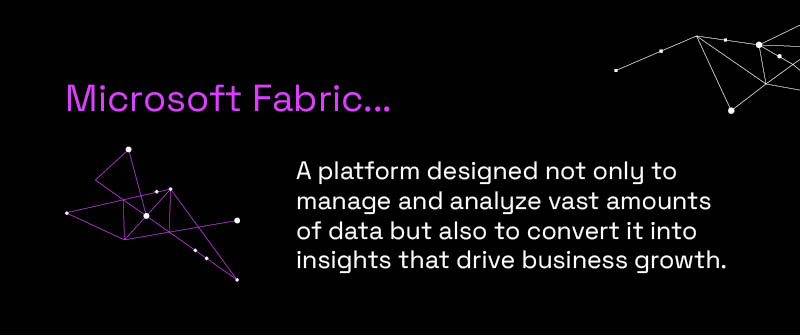
What Is the Microsoft Fabric?
Microsoft Fabric isn’t just another software in Microsoft’s extensive lineup. It’s an intricately designed platform aimed at managing, analyzing, presenting, and taking action on vast amounts of data.
It’s analogous to the backend engine that powers up a luxury vehicle, allowing it to run smoothly and efficiently on the most challenging terrains. For businesses, this ‘terrain’ is the data-driven market where decisions need to be made based on factual insights rather than mere hunches.
The Microsoft Fabric architecture is modular and scalable, ensuring that businesses, regardless of their size, can benefit from its capabilities. The goal is clear: provide a platform where raw data transforms into meaningful insights.
What Is Microsoft Fabric Used For?
We have likened data to gold. And like raw gold, raw data is of little use until refined. This is where Microsoft Fabric steps in. Microsoft Fabric is the modern-day oracle for businesses, offering glimpses into patterns, trends, and insights that were previously buried in heaps of data. Be it sales analytics, user behavior, market trends, or production statistics, Microsoft Fabric stands as a versatile sentinel. With the added convenience of the Microsoft Fabric admin portal, users can navigate, manage, and understand their data from a centralized location. This is pivotal for companies that aim to have a consolidated viewpoint of their operations.
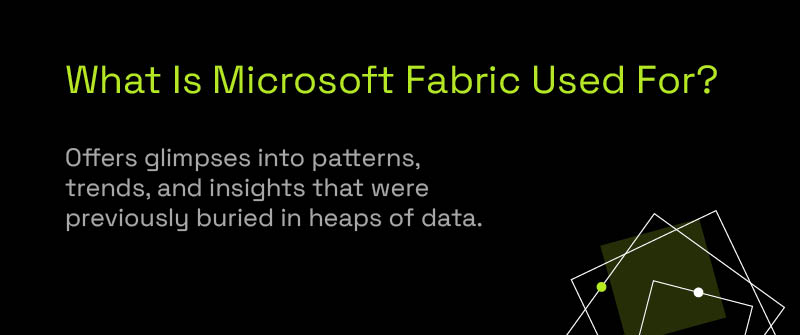
What Is the Cost of Microsoft Fabric?
When diving into the costs associated with Microsoft Fabric, it’s crucial to select the right fit for your organizational needs.
What Determines the Cost of Fabric?
Microsoft Fabric’s pricing revolves around its capacities. The choice of Fabric capacities is influenced by:
- Data Volume: How much data you’re managing and analyzing.
- Analytics Complexity: The depth and intricacy of the data analysis processes.
- User Load: The number of users interacting with and utilizing the system.
Payment Models:
There are two primary payment structures to consider:
- Pay-as-you-go: This is the adaptable choice, adjusting to your organization’s shifting data requirements. It’s especially suitable for unpredictable data volumes or if you’re still gauging long-term demands.
- Reserved Instances: This model involves a more long-standing commitment, offering reduced rates in exchange. It’s the go-to for organizations with consistent data usage patterns.
The table below shows a detailed pricing structure:
| SKU | Capacity units (CU) | Pay-as-you-go (hourly) | Pay-as-you-go (monthly) |
| F 2 | 2 | $0.36 | $262.80 |
| F 4 | 4 | $0.72 | $525.60 |
| F 8 | 8 | $1.44 | $1,051.20 |
| F 16 | 16 | $2.88 | $2,102.40 |
| F 32 | 32 | $5.76 | $4,204.80 |
| F 64 | 64 | $11.52 | $8,409.60 |
| F 128 | 128 | $23.04 | $16,819.20 |
| F 256 | 256 | $46.08 | $33,638.40 |
| F 512 | 512 | $92.16 | $67,276.80 |
| F 1024 | 1024 | $184.32 | $134,553.60 |
| F 2048 | 2048 | $368.64 | $269,107.20 |
To conclude, the suitable pricing model depends on aligning your business needs with the capacities offered. By examining both your current and future data requirements, you can make a well-informed decision that ensures value for money.
What Are the Benefits of Microsoft Fabric?
The platform’s benefits are multifaceted. Besides its potent data analytics capability, it aids businesses in the following.
Scalability
Microsoft Fabric architecture is designed for scalability, and it effortlessly scales to accommodate your growing data needs. Whether you have terabytes or petabytes of data, it can handle it. Additionally, Fabric provides high-speed data processing and analytics, ensuring that you get results quickly.
Cost-Efficiency
While the upfront Microsoft Fabric license might seem substantial, the long-term ROI due to efficient data management and insights-driven decisions make it a worthwhile investment.
Certification
Microsoft Fabric certification isn’t just another feather in the cap. It equips professionals with refined skills and ensures that your team has the necessary know-how to make the most of this powerful tool.
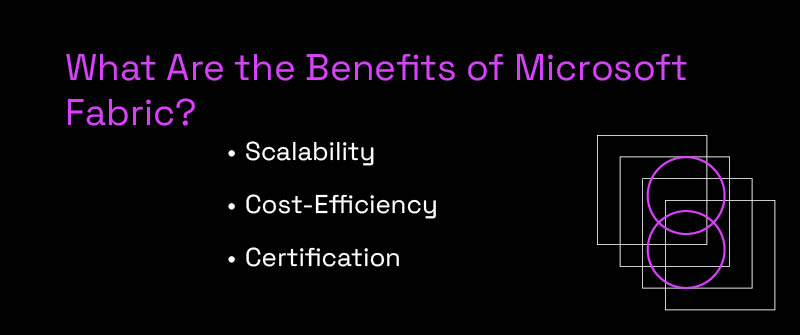
What Is Microsoft Fabric Capacity?
Capacity, in the context of Microsoft Fabric, is more about capability than capacity. It refers to the platform’s ability to handle extensive amounts of data efficiently. Imagine trying to fill a thimble with an ocean’s worth of water; similarly, businesses deal with torrents of data daily.
The robustness of Microsoft Fabric and Power BI premium capacity ensures that even the most overwhelming data streams can be managed, interpreted, and transformed into actionable insights.
Thanks to its scalability, you can begin with a smaller capacity and seamlessly expand as your data needs grow, ensuring that you always have the resources required for effective data analysis. Microsoft offers various capacity options to meet different needs, ensuring that organizations can choose the right level of performance and cost-effectiveness.
What Is the Microsoft Fabric Strategy?
Microsoft Fabric’s strategy is a triad of innovation, integration, and inclusivity.
Innovation
Regular software updates, introduction of cutting-edge features, and enhancements driven by user feedback ensure Microsoft Fabric remains avant-garde.
Integration
Its ability to synergize seamlessly with other software solutions enriches its utility, offering a more comprehensive solution to businesses.
Inclusivity
With Microsoft Fabric certification, users from diverse backgrounds, from tech aficionados to novices, can harness its capabilities to the fullest.
Is Microsoft Fabric Included With Power BI Premium?
While Microsoft Fabric and Power BI are siblings under the Microsoft umbrella, they are distinct products. Purchasing Power BI Premium (per User) doesn’t grant access to Microsoft Fabric by default. However, this access is included in the Power BI Premium per Capacity package. Power BI Premium is a more specialized tool focusing on data visualization. Nonetheless, their functionalities can complement one another, especially when integrated for cohesive data solutions.
Is Microsoft Fabric the Same As Power BI?
No, they aren’t the same. Power BI is excellent for creating visually appealing dashboards and reports and is a workload under the Microsoft Fabric umbrella. In contrast, Microsoft Fabric offers a broader spectrum of tools aimed at comprehensive data management and analysis. Think of Power BI as the artist painting the picture while Microsoft Fabric prepares the canvas chooses the colors, and even suggests themes based on the data it manages.
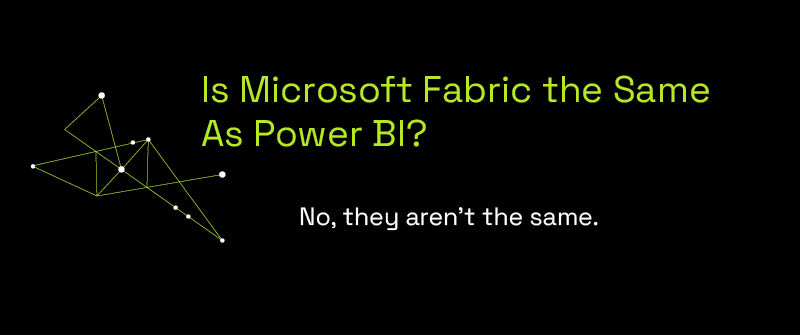
Is SAP Better Than Power BI?
SAP and Power BI are two sides of a coin. They cater to slightly different audiences. SAP, with its vast ERP systems, is a powerhouse in business operations. In contrast, Power BI is a data visualization specialist. Both have their strengths, and the better tool depends on the specific needs of the business.
Is There Anything Better Than Power BI?
The term “better” is contingent on context. Power BI is unparalleled for visualization-centric needs. However, if the requirement encompasses a gamut of data operations, from integration to advanced analytics, platforms like Microsoft Fabric offer a more encompassing solution.
Is Microsoft Fabric Part of 365?
Fabric isn’t a part of 365 by default. Let’s see: imagine an exquisite set of Russian Matryoshka dolls. Each one opens up to reveal another doll inside, each unique yet part of the same set. Now, think of Microsoft 365 as this set of dolls—with each application and service it offers being a doll within. While you might expect Microsoft Fabric to fit snugly within this nested lineup, given its impressive capabilities, it plays a different tune.
Microsoft Fabric, while harmoniously integrated with several Microsoft 365 applications, dances to its own rhythm and isn’t intrinsically nested within the 365 suite. It’s like an honorary member of the Matryoshka set—distinct yet integrable.
For users deeply enmeshed in the Microsoft 365 ecosystem, this means that while Fabric isn’t a default member, it integrates seamlessly, amplifying their data management and analytical prowess. This attribute makes it a must-have guest for businesses aiming to ace their data game.
Is Microsoft Fabric Good?
Microsoft Fabric isn’t just good; it’s exceptional.
Drawing on expert opinions from the tech community, Microsoft Fabric consistently garners praise for its robust architecture, user-centric design, and razor-sharp analytical capabilities. It’s like the Swiss Army knife for data—multi-faceted, efficient, and always up to the task.
For anyone still on the fence, consider this: in the ever-changing landscape of business technology, tools that don’t measure up quickly fade into obscurity. Yet, Microsoft Fabric stands tall, continually innovating and cementing its position as a leader in its domain. To circle back to the question—Is Microsoft Fabric good? It’s not just good; it’s revolutionary.
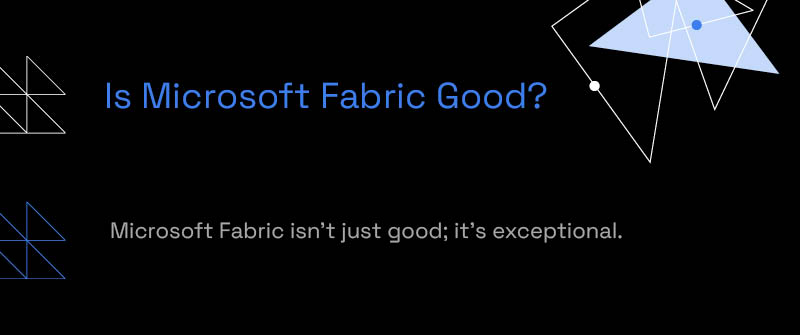
How Do I Enable Microsoft Fabric?
It’s essential to be aware of certain critical points before diving into it:
- Availability Constraints: Microsoft Fabric is not available in all regions. Always refer to the Fabric region availability for a comprehensive list.
Steps to Enable Microsoft Fabric:
Prerequisites:
- To initiate the Microsoft Fabric setup, ensure you possess one of the following admin roles: Microsoft 365 Global admin, Power Platform admin, or Fabric admin.
Enabling for Your Tenant:
- Access Tenant Settings: Navigate to the tenant settings in the admin portal. Locate and expand the option ‘Users can create Fabric items (public preview)’.
- Adjust Default Settings: Initially, uncheck the ‘Accept Microsoft’s default selection (Off for the entire organization)’ checkbox. This action is only necessary the first time you modify the Microsoft Fabric settings.
- Activate Creation of Fabric Items: Turn on the switch labeled ‘Users can create Fabric items (public preview)’.
- Specify User Groups: Optionally, utilize the ‘Specific security groups’ option to grant certain users access to Microsoft Fabric. Alternatively, you can activate Microsoft Fabric for the tenant and exclude particular users by opting for the ‘Except specific security groups’ selection.
- Confirm Changes: Select ‘Apply’.
Enabling for a Specific Capacity:
- Access Capacity Settings: Head over to the capacity settings in the admin portal.
- Choose Desired Capacity: Select the specific capacity where you want Microsoft Fabric to be enabled.
- Delegate Tenant Settings: Go to the ‘Delegate tenant settings’ tab. Under the ‘Microsoft Fabric (Preview)’ section, expand the ‘Users can create Fabric items (public preview)’ setting.
- Override & Activate: Check the ‘Override tenant admin selection’ checkbox and ensure the ‘Users can create Fabric items (public preview)’ setting is activated.
- Specify User Groups: As with the tenant-level settings, you can designate specific security groups or exclude particular groups.
- Confirm Changes: Select ‘Apply’.
Where P3 Steps In
As we’ve journeyed through its facets, it’s evident that Microsoft Fabric isn’t merely an option; for businesses keen on harnessing true data and computing power, it’s the gold standard.
We understand that data can feel overwhelming, especially when you’re at the starting line. However, here’s the silver lining: with us alongside, you’re never alone. Rely on our seasoned experts, who are equipped and eager to help you navigate every twist and turn. From the smallest queries to the most daunting challenges, we’re here, always ready to find solutions with you. You can start by reading up on some of our other Microsoft Fabric and Power BI content, or you can reach out to us directly.
Eager to be ahead in the data-driven future? Dive into the world of Microsoft Fabric. With unparalleled capabilities and a user-friendly interface, it’s the tool every business needs. Schedule a readiness call and start your data journey with the best in the business.
Get in touch with a P3 team member